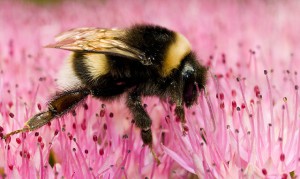Low bumblebee diversity in hedgerows next to conventional farms
A recent study published in the Journal of Insect Conservation has
found that agrochemical use in conventionally farmed fields decreases the benefit of hedgerows to bumblebees. Hedgerows, which are often planted alongside fields and roads, are thought to benefit bee pollinators by serving as bee habitat and by increasing the diversity of flowering plants available for bees to feed on. In order to determine the effects of agrochemical drift from conventional fields on bees in hedgerows, scientists compared the number of bee species and their abundance among 15 hedgerows placed along conventionally farmed arable fields and 15 hedgerows along roads. Findings showed the number of bumblebees foraging in hedgerows alongside roads was two times greater than the number of bumblebees foraging in field hedgerows. They also found that the number of flowering plant species and number of flowers were greater in hedgerows alongside roads than they were in field hedgerows. The authors suspect that agrochemical drift onto hedgerows from the arable fields are driving this result. Insecticide drift from fields could lead to bee deaths, leading to lower abundance and richness of bees in field hedgerows. Also, fertilizer drift from fields could allow fast-growing weeds to crowd out slower-growing plants leading to fewer flowering plants in field hedgerows. “Our results underscore the view that by virtue of reduced agrochemical inputs (and noting that our design eliminates the potentially confounding impacts of crop yield identified by Gabriel et al. [2013]), organic farming could benefit the floral abundance of arable field margins and so promote forage availability for pollinators,” the authors wrote.



